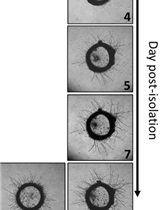- EN - English
- CN - 中文
Imaging the Vasculature of Immunodeficient Mice Using Positron Emission Tomography/Computed Tomography (PET/CT) and 18F-fluorodeoxyglucose Labeled Human Erythrocytes
利用正电子发射断层扫描/计算机断层扫描(PET、CT)和18F-氟脱氧葡萄糖标记人类红细胞 进行免疫缺陷小鼠脉管系统成像
发布: 2019年10月05日第9卷第19期 DOI: 10.21769/BioProtoc.3391 浏览次数: 5242
评审: Zinan ZhouAli Asghar KermaniFarah Haque
Abstract
Nuclear blood pool imaging using radiolabeled red blood cells has been used in the clinical setting for the evaluation of a number of medical conditions including gastrointestinal hemorrhage, impaired cardiac contractility, and altered cerebrovascular blood flow. Nuclear blood pool imaging is typically performed using Technetium-99m-labeled (99mTc) human erythrocytes (i.e., the “tagged RBC” scan) and gamma camera-based planar scintigraphic imaging. When compared to typical clinical planar scintigraphy and single-photon emission computed tomographic (SPECT) imaging platforms, positron emission tomography (PET) provides superior image quality and sensitivity. A number of PET-based radionuclide agents have been proposed for blood pool imaging, but none have yet to be used widely in the clinical setting. In this protocol, we described a simple and fast procedure for imaging the vasculature of immunodeficient mice through a combination of a small animal positron emission tomography/computed tomography (PET/CT) scanner and human erythrocytes labeled with the PET tracer 2-deoxy-2-(18F)fluoro-D-glucose (18F-FDG). This technique is expected to have significant advantages over traditional 99mTc -labeled erythrocyte scintigraphic nuclear imaging for these reasons.
Keywords: Blood pool imaging (血池显像)Background
Gamma camera-based imaging of radiolabeled erythrocyte is often used for visualizing the blood pool in nuclear medicine. For example, 99mTc-labeled human erythrocytes and 99mTc-labeled human serum albumin blood pool imaging with planar scintigraphy and single photon emission computed tomography (SPECT) have been used clinically to evaluate cardiac function (Thrall et al., 1978; Hacker et al., 2006; Mohseni et al., 2015), gastrointestinal bleeding (Sadri et al., 2015), vascular diseases (Liu et al., 2017), and orbital cavernous hemangioma (OCH) (Dong et al., 2017). As PET scanners have superior nuclear tracer sensitivity and image resolution compared to clinical gamma-camera scintigraphy and SPECT scanners (Rahmim and Zaidi, 2008), development of a robust PET-based blood pool imaging method is of significant clinical interest. Various PET tracers have been proposed as blood pool imaging agents, but suffer from certain limitations. For example, 15-oxygen-labeled (15O) H215O, 13-nitrogen-labeled (13N) 13NH3, 11-carbon-labeled (11C) 11C-Acetate and 82-rubidium chloride (82Rb) have been used to investigate myocardial blood flow, but are not widely used clinically, as the short radioactive half-life of 15O (122 seconds), 13N (9.97 minutes), 82Rb (76 seconds), and 11C (= 20.334 minutes) require the presence of a cyclotron in close proximity to the PET scanner or to an 82Rb generator. (Herrero et al., 2006; Nakazato et al., 2013; Lee et al., 2017). As the positron emitter 18-fluorine (18F) has a tracer half-life (108 minutes) well-suited for clinical imaging, 18F-based tracers are considered attractive for PET imaging, especially given the wide spread prevalence of FDG-specific PET imaging for oncology patients, as well as other 18F-based agents, such as 18F-fluorothymidine (18F-FLT) used for visualizing tumor proliferation (Cysouw et al., 2017).
In this protocol, we describe the method for labeling human erythrocytes with FDG and washing the FDG-labeled erythrocytes. We also describe the injection of labeled erythrocytes into NSGTM immunodeficient mice and subsequent imaging of the mouse vasculature using a small animal microPET/CT platform. Given that the erythrocyte labeling and washing procedure is straightforward, and that the FDG leakage rate from labeled erythrocytes is relatively slow (~10% in 46 min), we believe this method allows for robust PET imaging of the mouse vasculature. We believe that this imaging technique would be of interest to investigators seeking to visualize the vasculature of immunodeficient mice for other applications. In addition, we speculate that this technique would offer significant advantages over 99mTc-based nuclear blood pool imaging for the evaluation of occult gastrointestinal bleeding in patients, and may be useful for evaluating other clinical pathologies, including those involving the cerebral and myocardial vasculature.
Materials and Reagents
- 1.8 ml cryovial tube (Thermo Fisher Scientific, Thermo ScientificTM, catalog number: 343958)
- 3.5 ml cryovial tube (Thermo Fisher Scientific, Thermo ScientificTM, catalog number: 343958)
- 15 ml conical tube (Corning, catalog number: 430790)
- 400-600 µl Lithium Heparin tube (BD. Microtainer® catalog number: 365985)
- 1 ml sterile syringe (NIPRO Medical Corporation, catalog number: JD+01D2238)
- 10 cc BD Luer-LokTM disposable syringe (Thermo Fisher Scientific, catalog number: BD 309604)
- 15 ml FalconTM conical centrifuge tube (Thermo Fisher Scientific, catalog number: 14-959-53A)
- 10 ml and 25 ml FisherbrandTM Sterile Polystyrene Disposable Serological Pipets (Thermo Fisher Scientific, catalog numbers: 13-676-10F and 13-676-10M)
- 22 gauge needle (BDTM Needle 1, BD, catalog number: 305155)
- 26 gauge x ¾” mouse and rat tail vein Monoject IV catheter (Patterson Veterinary, catalog number: 07-836-8403)
- ParafilmTM M PM996 all-purpose laboratory film
- 200 µl and 1,000 µl TipOne sterile filter pipet tips (USA Scientific, catalog numbers: 1120-8810 and 1122-1830)
- 0.2 µm Nalgene® bottle top sterile filter unit (Sigma-Aldrich, catalog number: Z370576-12EA)
- 4-8 week old male splenectomized NOD.Cg-Prkdcscid Il2rgtm1Wjl/SzJ (NSGTM) immunodeficient mice (The Jackson Laboratory, stock number: 005557)
- 10 ml of human whole blood in standard ACD anticoagulant solution shipped next day (Zen-Bio, Inc, SER-WB10ML-SDS)
- 1 ml of 2-deoxy-2-(18F)fluoro-D-glucose (18F-FDG) with specific activity calibrated at a minimum of 20 milliCuries/ml at the time of cell labeling (United States Pharmacopeia (USP) grade, Cardinal Health nuclear pharmacy)
- 0.9% Sodium Chloride Injection USP, 100 ml Fill in 150 ml PAB® (B. Braun, NDC number: 00264-1800-32)
- 250 ml bottle of IsoThesia (Isoflurane) solution (Henry Schein Animal Health, catalog number: 029405)
- Sterile de-ionized water
- NaCl (Sigma-Aldrich, catalog number: S7653-1KG)
- KCl (Sigma-Aldrich, catalog number: P9333-1KG)
- K2EDTA dihydrate (Sigma-Aldrich, catalog number: 03660-1KG)
- Heparin sodium salt (Sigma-Aldrich, catalog number: 375095-100KU)
- Phosphate Buffered Saline (PBS) solution, pH 7.4 (Thermo Fisher Scientific, catalog number: 10010023)
- Filter sterilized 100 ml 5x EDTA solution (see Recipes)
- 100ml 1x EDTA solution (see Recipes)
- 1 Unit/ml of heparin-PBS solution (see Recipes)
Equipment
- Inveon PET/CT (Siemens Medical Inc., INVEN, catalog number: 138757)
- Centrifuge 5810 R (Eppendorf, catalog number: 108308)
- Centrifuge 5810 R (Eppendorf, catalog number: 119548)
- 200 µl single channel manual pipetter
- 1,000 µl single channel manual pipetter
- AtomLabTM 500 dose calibrator (Biodex Medical Systems, Inc)
- Tissue culture incubator (Sanyo Scientific, catalog number: 133060)
- Biological safety cabinet (The Baker company, SterilGARD, catalog number: 101951)
- Rotator platform (Labnet International, Inc GYROMINI)
- Blood Glucose Test Strips (TrueTrack from @Nitro Diagnostics TM (SN 7688648), Code 4698, Lot RS4698)
- BioVet® (m2m Imaging) physiological monitoring and heating system (m2m imaging Corp. USA. http://www.m2mimaging.com/)
Software
- Microsoft Excel program (Microsoft Excel 2010)
- Inveon PET/CT small animal imaging platform (Siemens Medical Inc., Knoxville, Tennessee)
- Inveon Workstation Software (Siemens Medical Inc., Knoxville, Tennessee)
- BioVet® (m2m Imaging) physiological monitoring and heating system (m2m imaging Corp. USA. www.m2mimaging.com)
Procedure
文章信息
版权信息
© 2019 The Authors; exclusive licensee Bio-protocol LLC.
如何引用
Wang, S. and Choi, J. W. (2019). Imaging the Vasculature of Immunodeficient Mice Using Positron Emission Tomography/Computed Tomography (PET/CT) and 18F-fluorodeoxyglucose Labeled Human Erythrocytes. Bio-protocol 9(19): e3391. DOI: 10.21769/BioProtoc.3391.
分类
癌症生物学 > 血管生成 > 动物模型 > 细胞迁移
细胞生物学 > 细胞成像 > PET/CT
您对这篇实验方法有问题吗?
在此处发布您的问题,我们将邀请本文作者来回答。同时,我们会将您的问题发布到Bio-protocol Exchange,以便寻求社区成员的帮助。
Share
Bluesky
X
Copy link











